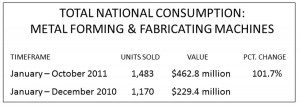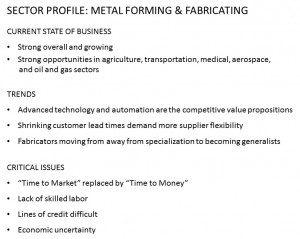2012 State of the Industry: Metal Forming & Fabricating Machine Tools
Forecast: Advanced technology and automation will keep this business sector strong overall and growing in the agriculture, transportation, medical, aerospace, and oil and gas sectors.
Posted: January 9, 2012
Forecast: Advanced technology and automation will keep this business sector strong overall and growing in the agriculture, transportation, medical, aerospace, and oil and gas sectors.
 J.D. Johnson
J.D. Johnson
President and CEO, Concise International, Inc.
Supplier of precision metal fabrications and complex sub-assemblies for medical equipment, elevator equipment and alternative energy, such as wind and solar power applications, among others.
CURRENT STATE OF BUSINESS
The outlook for 2012 looks very bright and strong, although we see the overall condition of the U.S. economy remaining generally tight for at least another year. While we are generally optimistic about the future, my number one concern remains the economy, followed closely by the political circus regarding real economic leadership.
For a positive outlook, the life science/medical, aerospace, and oil and gas sectors continue to show strength in the U.S. market. We also are seeing improvements in the general industrial manufacturing market that is being driven mostly by a positive trend of domestic customers bringing metal fabrication work back to the local market from China/Asia. This trend is extremely positive and whether it is being driven by political conditions, increased Asian labor costs, the logistics of overall cost of ownership, or the improved competitiveness of resilient U.S. manufacturers, it represents a serious boost to the sluggish U.S. economy.
We are finding that success in capturing this business is driven by a combination of our internal improvements in cost reductions, efficiency, positioning our investments in low cost manufacturing in the Southwest, and a dedication to improved responsiveness, quality performance and improved value proportion.
MAJOR TRENDS
During the coming year there are two important trends we are watching to determine how we might best position our company to take advantage of the opportunities.
First, technology remains an important contribution to our manufacturing competitiveness and ultimately to the value proposition our customers are looking for. There are many ways to define what we provide as a metal fabrication industry, but what our customers want is help in achieving success. Success is providing a product that is delivered on time every time, defect-free and competitively priced. In order for us to do this on a repetitive basis, we must implement the best technology available. Whether this involves the speed and performance of the next generation of fiber and CO2 laser equipment or tools to increase engineering productivity, we must evaluate how they can improve our business performance.
The second trend is how our customers are placing and committing to purchase orders. Almost every customer I speak with provides an overly optimistic view of the future quickly followed by an uncertainty about the economy. Our customers are unable to place the typical six-to-eight weeks in advance, even though their inventory levels remain at an all-time low. Most of our customers are placing orders with one to three weeks lead time, which is stressing our internal flexibility and supply chain responsiveness. Not recognizing this trend and implementing systems to meet this requirement will cause even the strongest business to quickly slip into a non-competitive position.
These two trends are having a major impact on our business, as we must make critical decisions regarding capital investments such as the flexibility of high speed laser cutting equipment to replace traditional tooling-intensive punch equipment at the same time that our customers are uncertain about order commitment. While these two items might seem unrelated on the surface, they speak to the same trend requirement of improved responsiveness, agility and overall flexibility that the market place is demanding.
CRITICAL ISSUES
As I see it, we have three critical issues facing the metal fabrications industry. The first critical issue is an optimistic customer outlook, but uncertainty in order placement, is driving increased demand for agility. The old adage of “time to market” is still critical, but for the successful metal fabrication business of tomorrow this adage must change to “time to money”. If we want to be successful we can’t continue to do business as we used to, we must become more responsive and agile to compete in today’s market.
We have evaluated the entire front end of our business and designed systems to improve our agility. In addition, we are instilling a culture that recognizes that “uncertain” is the foreseeable outlook for our customers and we can solve their problem, increasing our opportunity for growth by becoming a highly responsive supplier. Simply stated, Time to Market = Time to Money!
The second critical issue is skilled labor based on today’s technology. The issue of skilled manufacturing labor has been in the industry for a number of years, with fewer individuals entering the manufacturing labor market. However, the nature of the problem is changing as the type of skills needed is different today than it was a few years ago.
We used to think of skilled labor as the journeymen machinist and that without that skill we would have trouble competing. But in today’s requirements, the journeymen machinist is becoming more of a liability than a competitive advantage. The number one issue for many fabrication shops today is that we are not getting the full benefit of the technology in our factories. The labor force’s inability to engage, understand and take full advantage of the technology is holding our productivity hostage.
We have identified this issue and are investing in tools, training and recruitment of the next generation of employees. As business leaders, we need to do more to identify technology-savvy talent and help them understand that a manufacturing career can be very rewarding.
The third critical issue is a difficult capital market. For the foreseeable future, there will be little relief in the capital market and this means that we need to ensure a higher level of professional evaluation regarding the real ROI benefits of every capital dollar spent in the business. If the investment does not make an immediate impact on the business’ responsiveness, then it is most likely not money well spent. The payback must occur within weeks and months – not in years – otherwise the business will take on too high of risk.
Our company has access to capital other than from traditional banking sources, which is proving to be very beneficial. In May 2011 private equity investment firm Blackbird Management Group, LLC (Chicago, IL) acquired Concise Fabricators along with Conmex, which infused additional cash into the business. The fact that a group of investors values us enough to invest in us says a lot about the value of our company. It demonstrates that we can get the funding to install the equipment required for the business, which in today’s market is a strategic advantage.
Blackbird Management Group focuses on investing in middle-market business services and niche manufacturing companies and has over 50 years of “in the trenches” operating experience within those business and manufacturing areas.
PERSONAL INSIGHTS
On a number of fronts we are at a critical summit in the metal fabrication industry, as well as other manufacturing industries. The impact of two decades of the transfer of wealth from the U.S. economy due to the outsourcing of American jobs is more fully understood today, as it has weakened the economic fiber of our great country.
The notion that America will become a service sector economy, void of technology and engineering leadership but supported by manufacturing capability, is nothing more than nonsense. Our political leaders have the power and are in a position to influence the economic factors and give Americans the home court competitive advantage.
As business leaders we cannot stand by and expect these types of problems to solve themselves, or should we expect a handout. We must take an active role in identifying unfair competitive business conditions to our elected political representatives while also driving our business performance so that we are the supplier of choice.
Concise International, Inc., O’Hare Metal Products, 1101 Estes Avenue, Elk Grove Village, IL 60007, 847-439-4550, Fax: 847-439-8712, [email protected], www.oharemetal.com.
















